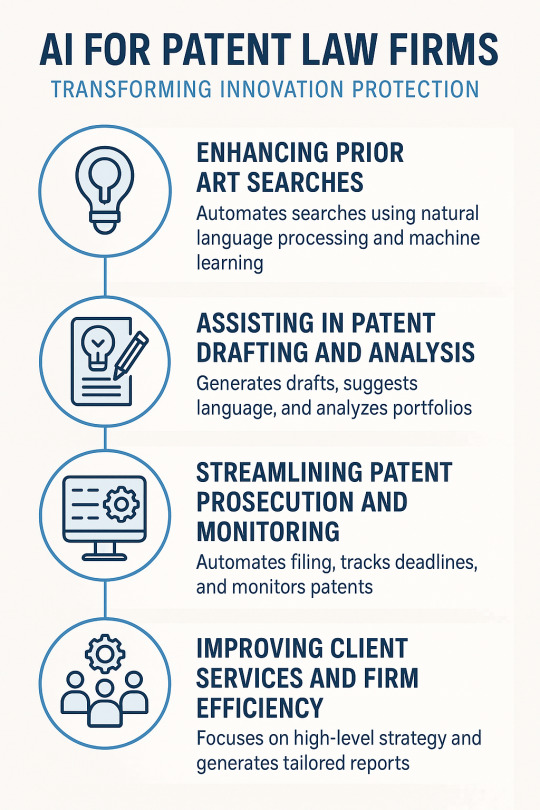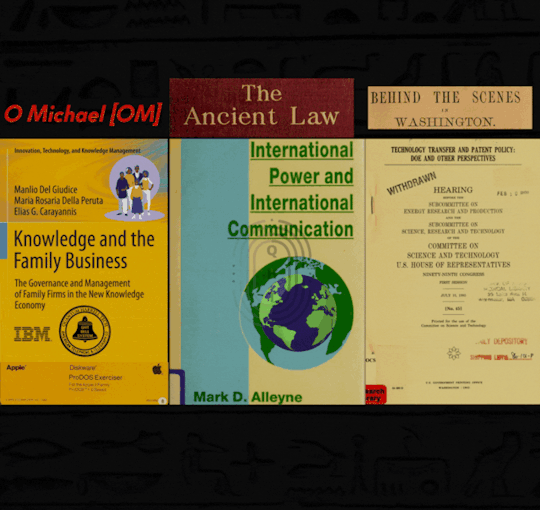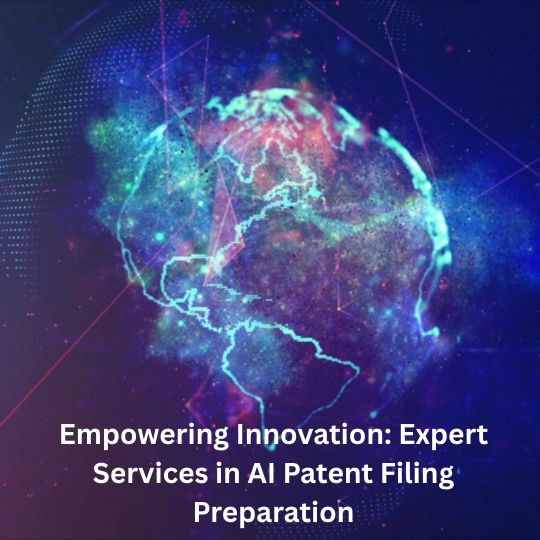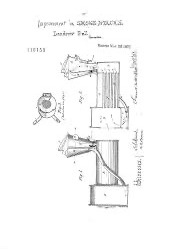#automated patent drafting
Explore tagged Tumblr posts
Text

AI for Patent Law Firms: Transforming Innovation Protection
In recent years, artificial intelligence (AI) has made significant inroads into the legal profession, and patent law firms are among the most promising beneficiaries. From automating prior art searches to drafting patent applications and streamlining portfolio management, AI is transforming how intellectual property (IP) professionals operate. As innovation accelerates globally, AI is proving indispensable in helping patent attorneys manage increasing workloads while maintaining the precision and strategic foresight that the field demands.
1. Enhancing Prior Art Searches
One of the most time-consuming tasks in patent prosecution is conducting thorough prior art searches. Traditionally, this required manually sifting through thousands of patent documents and scientific publications. Today, AI-powered search tools—leveraging natural language processing (NLP) and machine learning algorithms—can scan vast databases in seconds and return highly relevant results. These tools understand context and can identify similar inventions even when keywords differ, greatly improving both the speed and accuracy of search results. This enables attorneys to build stronger patent claims and avoid costly litigation risks.
2. Assisting in Patent Drafting and Analysis
AI is increasingly being used to assist in drafting patent applications by generating first drafts based on input claims and invention disclosures. While human oversight remains essential, AI tools can structure documents, suggest language based on existing patents, and even highlight inconsistencies or vague terminology. This not only accelerates the drafting process but also helps ensure compliance with the rigorous standards set by patent offices like the USPTO and EPO.
Moreover, AI tools can analyze existing patent portfolios to identify gaps, potential invalidity risks, or infringement threats. This enables firms to provide clients with strategic advice grounded in real-time data and comprehensive patent landscape analysis.
3. Streamlining Patent Prosecution and Monitoring
Patent prosecution involves extensive communication with patent offices, which can be delayed by human bottlenecks. AI can automate much of this process, including filing forms, tracking deadlines, and managing office actions. It can also analyze examiner behavior patterns to predict outcomes or suggest alternative claim strategies, giving firms a competitive edge.
Furthermore, AI can monitor granted patents and publications globally, alerting attorneys to competitor filings or infringement risks. Such capabilities are invaluable in sectors like biotechnology, software, and telecommunications, where overlapping IP rights are common.
4. Improving Client Services and Firm Efficiency
AI also empowers patent law firms to offer more value-driven services. By automating routine tasks, attorneys can focus more on high-level strategy and client engagement. AI-based tools can generate reports, dashboards, and risk assessments tailored to client needs, improving transparency and decision-making. Additionally, AI supports scalable operations, making it easier for firms to serve startups and large enterprises alike with consistent quality.
AI is not replacing patent attorneys—it’s empowering them. By enhancing efficiency, accuracy, and strategic insight, AI is becoming a vital partner in the practice of patent law. Forward-thinking firms that embrace AI are better positioned to navigate the complexities of modern IP management and deliver superior outcomes for their clients. As the legal tech landscape evolves, AI will play a central role in shaping the future of patent protection and innovation strategy.
Read More:
Here're The 10 Best AI Tools for Patent Drafting in 2025
#AI for patent law firms#patents#innovation#AI patent assistant#automated patent drafting#IP automation tool
0 notes
Text
quantumharrelltelecom.tech’s Quantum Dara™ [quantumdara.com] Assistant Network to 1698att-internetair.com’s Private Domain Communication [D.C.] Portal Address [PA] of 1698 qdara.tech’s 1968 quantumharrelltech.com Domain of Digital Sovereignty [DDS]… Digitally CREATING [D.C.] ANU GOLDEN 9 Ether [AGE] 2023-2223 WEALTH INDEX of Financial Independence [Wi-Fi]… since I.B. Microsoft’s [IBM’s] Implemented Control-Alt-Delete [iCAD2.com] Proprietary Language Learning Computer [LLC] PATENT Architect [PA] of Automated [PA] Integrated Drafting [PAID] Graphic Design Web Format [DWF] Files on Autodesk.com’s Interactive [A.i.] Technical Data Software [TDS] Network [TN]… Logistically [TNL] Looping Licensed Communication [LLC] Systems w/Intelligent METADATA [I’M] ENCRYPTIONS of quantumharrelltech.com’s Highly Complex [ADVANCED] Ancient 9 Ether Cosmic Algorithmic [CA] Computational [Compton] STAR WEB GATEWAY Language Architecture [L.A.] Embedded w/Optical IP Switching [OIS] Network Connections Electronically Transferring [E.T.] Alternate [ETA] Direct Currency [D.C.] CAPITAL [D.C.] from enqi-nudimmud.com’s GOLDEN Earth [Qi] MINING ESTATE [ME] of 1968-michaelharrelljr.com Using Official quantumharrelltech.ca.gov Military Hardware [MH] and Vendor-Independent Encryption Framework called 6g-quantumharrell.tech’s BLK-CRYPTO LLC @ quantumharrelltelecom.tech
WELCOME BACK HOME IMMORTAL [HIM] U.S. MILITARY KING SOLOMON-MICHAEL HARRELL, JR.™

i.b.monk [ibm.com] mode [i’m] tech [IT] steelecartel.com @ quantumharrelltech.ca.gov

Quantum Computing Intel Architect [CIA] Technocrat 1968-michaelharrelljr.com @ quantumharrelltelecom.tech

1968-michaelharrelljr.com ANU GOLDEN 9 ETHER [AGE] kingtutdna.com Genetic LUZ Clone KING OF KINGS LORD OF LORDS… Under the Shadow [U.S.] of Invisible MOON [I’M] RITUALS in Old America [MU ATLANTIS]

ommmmm.tech wealth @ quantumharrelltech.com

ommmmm.tech wealth @ quantumharrelltech.com

ommmmm.tech wealth @ quantumharrelltech.com

ommmmm.tech wealth @ quantumharrelltech.com

ommmmm.tech wealth @ quantumharrelltech.com

ommmmm.tech wealth @ quantumharrelltech.com

ommmmm.tech wealth @ quantumharrelltech.com

ommmmm.tech wealth @ quantumharrelltech.com

ommmmm.tech wealth @ quantumharrelltech.com

ommmmm.tech wealth @ quantumharrelltech.com

ommmmm.tech wealth @ quantumharrelltech.com

ommmmm.tech wealth @ quantumharrelltech.com

ommmmm.tech wealth @ quantumharrelltech.com

ommmmm.tech wealth @ quantumharrelltech.com

ommmmm.tech wealth @ quantumharrelltech.com

ommmmm.tech wealth @ quantumharrelltech.com

ommmmm.tech wealth @ quantumharrelltech.com

ommmmm.tech wealth @ quantumharrelltech.com

ommmmm.tech wealth @ quantumharrelltech.com

ommmmm.tech wealth @ quantumharrelltech.com

ommmmm.tech wealth @ quantumharrelltech.com

ommmmm.tech wealth @ quantumharrelltech.com

ommmmm.tech wealth @ quantumharrelltech.com

EYE SEE U B4 U C ME... I [MI = MICHAEL] ALL [MA] SEEING EYE ILLUMINATI

ommmmm.tech wealth pyramid @ quantumharrelltech.com

© 1698-2223 quantumharrelltech.com - ALL The_Octagon_(Egypt) DotCom [D.C.] defense.gov Department Domain Communication [D.C.] Rights Reserved @ quantumharrelltech.ca.gov
#u.s. michael harrell#kang solomon#quantumharrelltech#king tut#mu:13#harrelltut#kemet#o michael#quantumharrelltut#i need a new wealth index#trillionaire#quadrillionaire#sextillion#department of defense#quantum dara#qdara#quantum family banking in switzerland
2 notes
·
View notes
Link
#AIproductivity#ComplianceTech#enterpriseAI#hybrid-deployment#predictiveassistance#RegionalAdoption#regulatoryinnovation#workflowautomation
0 notes
Text
9 Best AI Agents to Make Your Work Life Easier

In today’s fast-paced digital economy, the ability to work smarter — not just harder — is the key to staying ahead.
That’s where AI agents come in. These intelligent digital tools are reshaping the professional landscape by handling repetitive tasks, accelerating decision-making, and boosting productivity.
Whether you’re a knowledge worker, legal expert, creative, or executive, there’s an AI agent built to help you streamline your day.
Here are nine of the best AI agents that can make your work life significantly easier.
1. ChatGPT (OpenAI)
Best for: Writing, brainstorming, coding, summarizing, customer support
ChatGPT is one of the most versatile AI assistants available. It can write professional emails, generate code, draft reports, brainstorm ideas, or even help with customer service inquiries. With its conversational interface and powerful capabilities, it serves as a personal assistant for nearly any professional need.
2. Notion AI
Best for: Project management, note-taking, document automation
Notion AI integrates directly with the Notion productivity platform. It enhances your notes by automatically summarizing meetings, generating to-do lists, and even drafting documentation. It’s perfect for busy professionals who collaborate across teams or need structure in their workflows.
3. GrammarlyGO
Best for: Writing enhancement, tone adjustment, communication
GrammarlyGO goes beyond basic grammar checking. It adapts your writing to different tones, rewrites awkward phrasing, and even generates full responses based on context. Professionals in communications, HR, and sales find it indispensable.
4. Copy.ai
Best for: Marketing, copywriting, social media content
If you’re in marketing or need to create compelling content fast, Copy.ai can generate product descriptions, ad copy, email campaigns, and blog posts in seconds. Its AI-powered writing engine saves hours of manual effort and inspires new ideas.
5. Otter.ai
Best for: Meeting transcription, documentation, speaker identification
Otter.ai is the go-to tool for real-time transcription. It automatically records, transcribes, and summarizes meetings, which is a lifesaver for team leaders, researchers, and HR professionals. The ability to tag speakers and extract key insights makes it even more powerful.
6. Microsoft 365 Copilot
Best for: Office suite automation, report generation, task management
Microsoft’s AI-powered Copilot integrates seamlessly with Word, Excel, PowerPoint, and Teams. It can automate tasks like drafting presentations, summarizing long documents, or analyzing data in Excel. It’s like having a full-time digital assistant embedded in your workflow.
7. Claude (Anthropic)
Best for: Ethical AI use, safe and reliable decision-making, customer service
Claude is a conversational AI developed by Anthropic with a focus on safety and transparency. It’s ideal for companies that require ethical AI tools in sensitive sectors like healthcare, education, or finance. Claude excels in answering questions, processing documents, and assisting with policy creation.
8. Gemini (Google DeepMind)
Best for: Data integration, research, cross-platform assistance
Gemini is a new-generation AI agent designed to understand and act across multiple platforms and data sets. It’s ideal for complex research tasks, market analysis, and multi-channel strategy planning. Professionals in finance, law, and tech consulting will find it particularly useful.
9. Peerless AI Agents for IP Professionals
Best for: For those in intellectual property (IP) law, R&D, or innovation management, ipagent.ai offers AI agents tailored to the specific needs of IP professionals.
IP Agent AI is an advanced agent‑driven platform designed specifically for intellectual property professionals, automating key IP workflows like patent drafting, translation, and novelty searches with remarkable speed and accuracy.
AI Agents Are the New Work Superpower
The rise of AI agents marks a significant shift in how professionals manage their workloads. From automating simple tasks to aiding in high-stakes decision-making, these tools are transforming industries across the board.
Whether you’re managing a team, filing a patent, crafting a marketing campaign, or simply trying to get through your to-do list faster — there’s an AI agent built just for you.
Start experimenting with one or two of these tools today. You may find that the future of work is not just more productive — but also a whole lot easier.
Read More:
Agentic AI - What is an Agentic AI system?
#AI Agents#IP Agents#AI#AI Agents for Work#Work Smarter#ChatGBT#Claude#Otter#Notion AI#agentic ai system
0 notes
Text
The Future of Legal Services: Integrated IP, Tech & LPO Support
The Future of Legal Services: Integrated IP, Tech & LPO Support
The legal industry is undergoing a profound transformation. Traditional models of delivering legal services—often rigid, manual, and expensive—are giving way to more agile, technology-driven, and cost-effective solutions. At the heart of this shift lies the integration of three critical components: Intellectual Property (IP) support, Legal Process Outsourcing (LPO), and Legal Technology (LegalTech).
As we move further into 2025, the integration of these services is not just a trend—it’s becoming essential for firms aiming to remain competitive, innovative, and client-focused.
The Rise of Integrated IP Services
Intellectual Property has become a key asset in a knowledge-based economy. From startups to Fortune 500s, businesses are increasingly focused on protecting innovations and navigating complex patent and trademark landscapes. Yet, IP processes—from patent searches to drafting and filing—require highly specialized skills and significant resources.
This is where integrated IP support comes in. Legal service providers now offer everything from prior art searches, patent drawings, docketing, and portfolio management to litigation support under one umbrella. By outsourcing these tasks to dedicated experts, law firms and corporates can ensure accuracy, save time, and reduce costs—all while focusing their internal resources on high-value strategy and client engagement.
LPO: A Strategic Shift, Not Just Cost Cutting
Legal Process Outsourcing has matured far beyond the early days of simple document review and transcription. Today, LPO providers are taking on complex functions like legal research, contract lifecycle management, e-discovery, and compliance monitoring.
The key shift in 2025 is that LPO is no longer just about cost reduction. It’s about scalability, speed, and strategic advantage. Firms can access on-demand legal talent, ensure 24/7 support across time zones, and manage work in multiple languages. This is especially vital for firms dealing with high-volume cases, global clients, or complex regulatory environments.
LegalTech: The Engine Behind Integration
LegalTech is the backbone enabling this integration. AI-powered tools for legal research, contract analysis, and IP analytics are now standard offerings in modern legal service platforms. Automation is streamlining repetitive tasks, while data-driven insights are helping legal teams make better, faster decisions.
Integrated platforms combine IP tools, LPO dashboards, and legal tech solutions in a unified interface. This reduces inefficiencies, enhances collaboration, and improves client outcomes. Cloud infrastructure ensures secure access to legal work from anywhere, while analytics help firms track turnaround times, quality, and performance metrics.
What This Means for Legal Teams
For law firms and in-house counsel, this integrated model offers a new way of working. It breaks down silos between IP, operations, and technology. It fosters more predictable billing, better client communication, and more agile legal teams.
Firms that embrace this model early will be positioned as forward-thinking, efficient, and client-centric. Those that don’t risk falling behind in a legal landscape that’s evolving faster than ever before.
Conclusion: The future of legal services lies in integration—where IP support, LPO, and LegalTech come together to create smarter, leaner, and more responsive legal ecosystems. In 2025 and beyond, this is not just a competitive edge—it’s the new normal.
0 notes
Text
Empowering Innovation: Expert Services in AI patent filing in india

AI patents protect inventions that involve artificial intelligence technologies, such as machine learning algorithms, neural networks, and intelligent automation systems. These patents ensure exclusive rights over innovative AI-based solutions, offering a competitive edge in a rapidly evolving digital world. Einfolge Technology offers end-to-end AI patent filing in india — from prior art search, novelty analysis, and patent drafting to filing and prosecution. With a deep understanding of both AI technologies and global IP regulations, Einfolge ensures your innovations are accurately protected and strategically positioned in the patent landscape.
0 notes
Text
Don’t end humanity
(Lean into the mic, deadpan) “Who even thinks it’s a good idea to separate content from its copyright? It’s like decoupling a calorie from its nutritional value and wondering why your Fitbit thinks you’re dead. We did this. We built systems where an AI-generated cat meme pirating the Mona Lisa triggers 47 automated DMCA takedowns… only to train another AI pumping out more illegal Renaissance cats. It’s a perpetual infringement machine!
(Pacing, hands in pockets) You know you’re in the Bay when people treat copyright like an alignment problem. ‘Have we specified the utility function of intellectual property, or are we just optimizing for lawyer GDP?’ I overheard someone at Coupa Cafe trying to model copyright law in a spreadsheet to find the ‘optimal’ infringement loophole. Conclusion? Mickey Mouse should be public domain… unless Disney’s lobbying budget gets its own AGI. Multiverse theory’s getting spicy, folks.
(Mock-conspiratorial) They say ‘information wants to be free’—cool, but copyright wants a gated Atherton estate with armed guard llamas. And now we’ve got blockchain evangelists trying to enforce copyright on a system designed to dodge rules. It’s like herding cats with a laser pointer made of red tape. We’ve built a system less enforceable than a pinky swear at a rationalist potluck.
(Sips water, raises eyebrows) Our tech just doubles down on the mess. Spotify’s ‘Discovery Weekly’ is a Bayesian filter for ‘songs you’ll like that haven’t sued us yet.’ OpenAI’s legal team spends more time on copyright clearance than AI safety. ‘Priorities: 1. Don’t end humanity. 2. Don’t let Taylor Swift sue us over a ballad about sentient toasters.’
(Climactic gesture) We’re barreling toward a copyright singularity. One day, an AGI will churn out truly original content… and instantly copyright it in a jurisdiction run by sentient patent trolls. Forget the paperclip maximizer—meet the DMCA-maximizer: it turns the universe into unlicensed fan fiction of itself.
(Shrugs, walks off) So, if you steal this bit? My lawyer’s already drafting a cease-and-desist in 17 dimensions. Good luck explaining that to your AI overlord.”
0 notes
Text
How IP Management Software Streamlines Patent and Trademark Processes

Managing intellectual property in today’s complex business environment is far more than tracking a few filing dates. With global innovation accelerating, businesses now face increasing volumes of patents, trademarks, copyrights, and trade secrets—each demanding precise attention and organization. This is where IP management software becomes a game-changer.
By streamlining patent and trademark processes, IP management software empowers legal teams, R&D departments, and innovation managers to maintain control, reduce errors, and maximize the value of their IP assets.
This blog dives deep into how this specialized software simplifies complex workflows and enhances strategic decision-making around your intellectual property.
Understanding the Complexity of Patents and Trademarks
The Patent Process
Filing and managing a patent involves several key stages:
Researching prior art
Drafting and submitting patent applications
Responding to office actions
Paying maintenance fees
Monitoring for infringement Each of these stages requires extensive documentation, timely communication, and strict adherence to deadlines.
The Trademark Lifecycle
Trademarks go through:
Clearance and registration
Opposition periods
Renewals every 5–10 years
Infringement monitoring and enforcement Without a centralized system, managing these assets can quickly become overwhelming—especially for organizations with a global footprint.
What Is IP Management Software?
IP management software is a specialized digital tool designed to help organizations organize, monitor, and protect intellectual property assets. It automates routine tasks, keeps track of legal deadlines, and provides comprehensive reporting for better strategic insights.
Whether you’re a law firm, a tech company, or a university, this software plays a critical role in minimizing IP risk and maximizing return on innovation.
Key Ways IP Management Software Simplifies Patent Processes
1. Centralized Patent Portfolio Management
All patent-related documents, filing dates, and jurisdictional data are stored in a single platform. This centralization reduces duplication and ensures easy access to the latest versions of each file.
Benefits:
Better visibility across international filings
Easier management of multiple assignees or inventors
Quick access to key documentation
2. Automated Deadline Alerts
Missing a patent renewal or office action deadline can result in lost rights. IP management software automatically notifies teams of upcoming deadlines, helping them stay compliant with global patent office requirements.
Features may include:
Customizable reminders
Integration with patent office databases
Visual dashboards for deadline tracking
3. Patent Cost Tracking
Patent filing and maintenance come with significant costs. Advanced tools allow you to track:
Filing fees by jurisdiction
Legal and attorney expenses
Maintenance fee timelines
This makes it easier to budget for future filings and assess the ROI of each patent family.
4. Workflow Automation
Rather than manually routing tasks between attorneys, engineers, and administrators, the software automates:
Application review processes
Approval chains
Patent transfer or licensing workflows
Automation reduces administrative burdens and speeds up your time to filing.
How IP Management Software Streamlines Trademark Management
1. Trademark Search and Clearance Integration
Before filing a new mark, thorough research is essential. Many platforms integrate with national and international databases to streamline the trademark search process.
Key advantages:
Reduce risk of conflicts and opposition
Search similar names, logos, or slogans across jurisdictions
2. Opposition Monitoring and Alerts
Once filed, trademarks go through opposition periods. Your software will:
Monitor pending applications from competitors
Alert you to similar filings
Help you respond during opposition windows
3. Trademark Renewal Management
Trademark renewals typically occur every 5 to 10 years. Your IP management software will:
Track each mark’s renewal schedule
Provide reminders for upcoming dates
Organize jurisdiction-specific renewal procedures
4. Infringement Watch Tools
The software can integrate with watch services to:
Monitor for similar marks
Flag potential infringements
Suggest legal next steps
Strategic Benefits of Using IP Management Software
Improved Collaboration
Legal, R&D, and business units can access and contribute to the same centralized system, improving collaboration and reducing communication errors.
Enhanced Reporting
Through customized dashboards and downloadable reports, teams can analyze:
IP asset performance
Filing timelines
Global IP distribution This information supports smarter IP strategy and innovation investment.
Risk Mitigation
Timely alerts and workflow consistency help prevent missed deadlines, data entry errors, and non-compliance with regional IP laws.
Cost Efficiency
By consolidating your IP operations into one streamlined platform, you reduce reliance on external counsel for routine tasks, saving money in the long term.
LSI Keywords to Look for When Evaluating Tools
Make sure the software mentions or supports the following terms, which indicate robust functionality:
Patent docketing software
Trademark portfolio management
Legal document automation
Intellectual property tracking
IP filing lifecycle tools
Trademark renewal scheduler
Global IP compliance system
IP data analytics dashboard
Infringement monitoring integrations
IP cost management software
Questions to Ask Before Choosing a Platform
Does the software integrate with national patent/trademark offices?
Can I track both domestic and international IP assets?
Is it scalable for portfolio growth?
Does it offer real-time collaboration tools?
Are reporting features customizable?
How secure is the data stored on the platform?
Does it support integration with billing or CRM software?
Real-World Example Scenarios
Scenario 1: Patent Filing Across Multiple Countries
Your team is preparing a patent application to be filed in the U.S., Europe, and Asia. With IP management software, the filing timelines, translations, and jurisdictional rules are all tracked in a single workflow—ensuring nothing is missed and deadlines are coordinated.
Scenario 2: Trademark Enforcement
You receive a notification that a competitor has filed a logo that looks similar to your brand. The infringement monitoring feature flags it automatically, allowing your legal team to act quickly during the opposition period.
Scenario 3: Strategic Reporting for the C-Suite
Your executive team needs a quarterly update on your IP portfolio's performance. With built-in analytics tools, you generate visual reports showing cost trends, portfolio size by category, and expiration timelines—instantly.
FAQs
What’s the difference between patent and trademark management in IP software?
Patent management focuses on the lifecycle of innovations and inventions, while trademark management tracks branding elements like logos and names. Most platforms handle both under separate modules.
Can small businesses benefit from IP management software?
Yes. Even businesses with a few trademarks or patents can benefit from better organization, deadline tracking, and cost forecasting.
Is cloud-based or on-premise software better for IP management?
Cloud-based solutions offer flexibility, scalability, and remote access. On-premise may offer higher customization but often requires more IT support.
How often should I update my IP data in the software?
Ideally, your data should be updated in real-time or on a weekly basis to ensure accurate tracking and compliance.
Does IP management software replace the need for an IP attorney?
No, but it reduces their manual workload, enabling attorneys to focus on strategy and enforcement rather than administrative tasks.
Conclusion
From patent filings and renewals to trademark monitoring and infringement prevention, IP management software dramatically simplifies how businesses handle intellectual property. It improves accuracy, saves time, reduces costs, and strengthens strategic decision-making.
If your organization is serious about innovation, branding, and protecting its competitive edge, investing in the right IP management software is not just an option—it’s a necessity.
Start exploring solutions today that offer centralized dashboards, automated alerts, and seamless collaboration features. The future of IP is digital, and your competitive advantage depends on it.
0 notes
Text

Landrow Bell, an inventor from DC patented an improved locomotive smokestack design on May 23, 1871. His design created a downward draft to prevent sparks and cinders from escaping the chimney and potentially harming passengers or combustibles. He patented a dough kneader on December 10, 1872.
He was born in St. Louis and received a Business Administrator degree from Lincoln University in 1940. In 1872, he patented an improved dough kneader that automated the kneading process to be faster and more uniform. #africanhistory365 #africanexcellence
0 notes
Text
SolidWorks CAD Software: A Complete Guide to 3D Design, Modeling, and Engineering Innovation

In today’s fast-paced world of engineering and product development, the ability to visualize and simulate designs before production is critical. This is where SolidWorks CAD Software plays a transformative role.
As one of the leading computer-aided design (CAD) tools in the industry, SolidWorks empowers engineers, designers, and manufacturers to create high-quality 3D models, run simulations, and produce detailed drawings for all types of products. From simple mechanical components to complex machinery and assemblies, SolidWorks provides a user-friendly yet powerful platform for innovation.
What is SolidWorks CAD?
SolidWorks CAD (Computer-Aided Design) is a 3D modeling software developed by Dassault Systèmes. It is widely used across industries like automotive, aerospace, electronics, consumer goods, and manufacturing for creating precise 3D models and 2D drawings. SolidWorks offers a suite of tools that include part modeling, assembly design, sheet metal work, mold design, and more.
The software is parametric, which means users can create models based on mathematical relationships. This allows easy modifications and design iterations without starting from scratch. Whether you’re designing a single part or a full mechanical system, SolidWorks helps maintain consistency and accuracy throughout the development cycle.
Key Features of SolidWorks
3D Modeling: The core of SolidWorks is its powerful 3D modeling capabilities. You can create complex parts and assemblies with ease, using intuitive sketching tools and feature-based modeling.
Simulation and Analysis: With SolidWorks Simulation, engineers can test their designs under real-world conditions. This includes stress analysis, thermal testing, motion studies, and fluid dynamics.
Drawing and Documentation: SolidWorks automatically generates detailed 2D drawings from 3D models. These drawings include dimensions, tolerances, material specs, and annotations that meet industry standards.
Sheet Metal Design: Specialized tools for creating sheet metal parts, including bend allowances, flat patterns, and unfolding operations.
Weldments and Structures: Design and analyze frames, trusses, and structural components using weldment features and standard profiles.
Assemblies and Interference Checking: Assemble multiple components into a single system and use tools to detect clashes and interference before manufacturing.
Integration and Collaboration: SolidWorks integrates seamlessly with other tools like PDM (Product Data Management) and PLM (Product Lifecycle Management) systems. It also supports collaborative design through cloud-based platforms.
Benefits of Using SolidWorks CAD
Increased Productivity: With parametric design and automation tools, repetitive tasks are minimized, enabling designers to work faster.
Cost-Effective Development: Simulating designs before production helps in identifying errors early, reducing the cost of rework and physical prototyping.
Better Visualization: 3D modeling provides a realistic view of the final product, aiding in presentations, marketing, and customer approvals.
Industry Compliance: SolidWorks supports global drafting standards (ISO, ANSI, DIN), making it suitable for multinational projects.
Scalability: Whether you are a freelancer, a startup, or a large corporation, SolidWorks offers scalable licensing and feature sets to fit your needs.
Who Uses SolidWorks?
SolidWorks is used by:
Mechanical engineers for product design and simulation.
Industrial designers for aesthetic and ergonomic modeling.
Manufacturing teams for CNC machining and tooling design.
Students and educators for academic learning and projects.
Startups and inventors for prototyping and patenting new ideas.
Future of SolidWorks CAD Software
The future of SolidWorks is evolving with trends like cloud computing, artificial intelligence, and real-time collaboration. Dassault Systèmes continues to enhance SolidWorks with cloud-based design tools under the 3DEXPERIENCE platform, allowing teams to work from anywhere and manage projects more efficiently.
With increasing integration of AR/VR and AI-powered design suggestions, SolidWorks aims to further reduce development time and enhance innovation. Staying updated with its latest versions ensures users have access to the newest tools and features.
Conclusion
SolidWorks CAD Software is not just a design tool—it is a complete solution that bridges creativity, engineering, and production. Its user-friendly interface, powerful simulation features, and robust support community make it the go-to choice for professionals across the globe. Whether you're building the next big invention or streamlining manufacturing operations, SolidWorks can bring your ideas to life with precision and efficiency.
Stay ahead in design and innovation with Tech Savvy – your trusted partner in digital engineering solutions.
#Solidworks CAD Software#Solidworks Cad#autodesk autocad software In Haryana#SOLIDWORKS 3D CAD Software
1 note
·
View note
Text
The Future of Patent Drawings: AI and Automation in Illustration Services
Patent drawings are a critical component of the patent application process. They visually communicate the structure, function, and details of an invention in a way that words alone cannot. Traditionally created by skilled draftspersons, patent drawings have historically required precision, technical know-how, and strict adherence to regulatory standards. However, the emergence of Artificial Intelligence (AI) and automation is now reshaping how these illustrations are produced.
As we move further into a digitally driven world, technological advancements are revolutionising the future of patent drawings. This article explores how AI and automation are transforming patent illustration services and what that means for inventors, law firms, and intellectual property professionals.
Why Patent Drawings Matter
Before diving into how AI is changing things, it’s important to understand the foundational role of patent drawings in a utility or design patent application.
Patent drawings:
Support written claims with visual clarity
Help patent examiners understand the invention
Fulfil legal requirements in many jurisdictions
Improve the enforceability of the patent
Can reduce office actions and delays when accurate
Given their importance, creating patent drawings has traditionally required skilled professionals who understand both technical illustration and patent office regulations (such as those from the USPTO, EPO, or WIPO).
Current Challenges in Patent Drawing Preparation
Although patent drawings are a crucial part of the application process, their preparation remains largely manual and time-consuming. Several key challenges impact efficiency and quality:
Time-Consuming Drafting: Creating detailed, multi-view patent illustrations often requires hours or even days of meticulous work.
Risk of Non-Compliance: Minor errors in formatting, margins, line weights, or part labelling can result in costly rejections or delays.
Reliance on Specialised Expertise: Skilled patent illustrators are in limited supply and often come with high costs, making access difficult for many applicants.
Lengthy Revision Cycles: Multiple rounds of revisions between inventors and attorneys extend timelines and increase expenses.
These persistent pain points highlight the urgent need for innovation, opening the door for AI and automation to transform the patent drawing process.
The Rise of AI in Patent Drawing Services
AI is transforming industries worldwide, and patent illustration is no exception. In the context of patent drawings, AI and automation refer to technologies that can assist or completely generate illustrations using computational models.
Key Applications of AI in Patent Drawing Creation:
Auto-generation from CAD Files: AI tools can analyse 3D CAD models and automatically extract relevant 2D views (e.g., front, side, top, perspective). These views can be converted into compliant patent drawings with proper line weights and annotations.
Natural Language Processing (NLP): AI can read the technical specifications in patent drafts and generate corresponding visual layouts or suggest figure numbers and part labels based on contextual cues.
Intelligent Labelling and Numbering: AI can automate the repetitive task of assigning part numbers and ensure consistency across multiple figures, reducing human error.
Compliance Checks: AI can review drawings and flag issues such as improper margins, line thickness inconsistencies, or missing views, helping avoid common USPTO or PCT rejections.
Template Matching: For standard components (e.g., motors, gears, levers), AI can match the invention to a database of illustration templates, speeding up the creation process.
Automation in Workflow and Project Management
Beyond illustration, automation tools are being integrated into the project management side of patent drawing services:
Automated Client Portals: These allow inventors to upload reference materials and receive status updates in real time.
Auto-generated Quotes and Turnaround Times: Depending on the invention's complexity, platforms can estimate timelines and costs with minimal human intervention.
Collaborative Review Platforms: Tools that allow patent attorneys and clients to annotate drawings and approve versions online streamline the review and revision process.
Benefits of AI and Automation in Patent Drawings
1. Speed and Efficiency
AI-generated drawings can be produced in a fraction of the time it takes a human draftsperson. This acceleration shortens application timelines, giving inventors a competitive edge.
2. Cost Reduction
Automation reduces labour-intensive processes, cutting costs for both service providers and clients. Lower drawing costs make patent protection more accessible for startups and individual inventors.
3. Accuracy and Compliance
With built-in compliance algorithms, AI tools can help reduce the number of Office Actions due to drawing errors, improving approval rates.
4. Scalability
Large IP firms or multinational companies with high patent volumes can handle drawing workloads more effectively using AI and automation tools.
5. Consistency Across Jurisdictions
AI systems can be programmed to accommodate multiple regulatory standards (USPTO, EPO, JPO, etc.), ensuring drawings meet global requirements.
Limitations and Concerns
While AI offers significant advantages, it also comes with notable limitations:
Complex Inventions: AI tools may struggle to accurately interpret intricate or unconventional inventions without human guidance.
Lack of Visual Judgment: Decisions such as selecting the most informative view or adjusting illustrations for maximum clarity still benefit from human creativity and experience.
Security and Confidentiality: Using cloud-based AI platforms can raise concerns about the security of sensitive invention data and the risk of intellectual property exposure.
Regulatory Caution: Patent offices continue to emphasise the importance of human oversight. AI-introduced errors could compromise the application’s acceptance.
As a result, the most effective approach today is AI-assisted drafting—a hybrid model that leverages AI's speed and scalability while retaining human expertise to ensure precision, clarity, and compliance.
Case Study: AI in Action
An increasing number of patent illustration companies are adopting AI-driven tools to streamline the drafting process. These platforms typically offer capabilities such as:
Uploading a 3D CAD model
Selecting required views (e.g., top, side, cross-section)
Automatically labelling parts and numbering figures
Generating compliant, ready-to-submit drawings within minutes
Early adopters report a 60–70% reduction in turnaround time, with significantly fewer revision cycles thanks to minimised formatting errors. By automating routine tasks, AI allows illustrators and attorneys to focus on more strategic aspects of the application process.
What the Future Holds
As AI capabilities expand, the future of patent drawing services promises to be smarter, faster, and more integrated. Key developments on the horizon include:
End-to-End AI Workflows: From drafting to electronic filing, AI platforms may soon offer fully automated pipelines that handle illustrations, claims writing, and submission in one seamless process.
Voice-to-Drawing Interfaces: Advanced Natural Language Processing (NLP) could allow inventors to describe their ideas verbally and receive instant draft drawings, bridging the gap between concept and visualisation.
AR-Based Validation: Augmented reality environments may let users preview and interact with patent drawings in 3D, improving accuracy and communication before submission.
Blockchain-Backed IP Security: AI-generated illustrations could be timestamped and verified using blockchain technology, adding a new layer of protection and authenticity to IP assets.
These innovations hint at a future where patent drafting is not only more efficient but also more accessible, secure, and intuitive.
Final Thoughts
AI and automation are not here to replace professional patent illustrators, but to enhance and streamline their work. By automating routine tasks, flagging compliance issues, and speeding up the drawing process, these technologies offer immense value to inventors, patent attorneys, and IP firms.
The future of patent drawings lies in collaboration between machines and humans, where AI handles the heavy lifting and experts focus on strategy, creativity, and legal compliance. Embracing this change will be key to staying competitive in the evolving IP landscape.
0 notes
Text

Navigating the AI Revolution: A Strategic Guide for Patent Practice Leaders
Artificial Intelligence (AI) is transforming patent law by streamlining complex tasks, enhancing client service, and boosting firm efficiency. From automated prior art searches to draft generation and portfolio analysis, AI tools are rapidly evolving, offering patent attorneys powerful ways to manage growing workloads with precision.
For practice leaders, success hinges on strategic implementation. Beyond selecting the right tools, firms must ensure data security, seamless integration, and strict adherence to client confidentiality. Evaluating AI vendors for compliance, encryption, and legal training data is essential to reduce risks like AI "hallucinations."
To maximize AI’s impact, leaders must foster a culture of innovation and continuous learning. Designating internal AI champions, offering focused training, and hosting firmwide upskilling events can accelerate adoption and ensure meaningful application across workflows.
Clients expect tech-savvy legal partners. Law firms that embrace AI not only gain a competitive advantage but also attract top talent seeking cutting-edge environments. Establishing internal KPIs—like improved turnaround times and drafting efficiency—helps measure AI’s return on investment while improving client relationships.
In a fast-changing IP landscape, proactive leadership, strong governance, and a commitment to strategic AI adoption are key. Patent leaders must guide their teams with clarity, ensuring technology enhances—not replaces—the value attorneys deliver.
📌 Follow IP Consulting Group for more IP-related updates.
💼 IP Consulting Group is the right choice to fulfill your needs!
Contact Us
DC: +1 (202) 666-8377 MD: +1 (240) 477-6361 FL +1 (239) 292–6789 Website: https://www.ipconsultinggroups.com/ Mail: [email protected] Headquarters: 9009 Shady Grove Ct. Gaithersburg, MD 20877 Branch Office: 7734 16th St, NW Washington DC 20012 Branch Office: Vanderbilt Dr, Bonita Spring, FL 34134
#IPConsultingGroup#AIinLaw#PatentLeadership#LegalTech#AIforAttorneys#IntellectualProperty#PatentStrategy#LawFirmInnovation#LegalAIRevolution#FutureOfIPLaw
0 notes
Text
Industry trend|ZiPIoT: The first innovative application of RFID in DNA management, with huge potential market space
Today, as the wave of digital transformation sweeps the world, Guangzhou ZiPIoT Technology Co., Ltd. (hereinafter referred to as "ZiPIoT") has become a bright new star in the field of the Internet of Things with its profound technical accumulation and innovation capabilities. As a high-tech enterprise, a Guangdong Provincial Science and Technology Little Giants registered enterprise and the drafting unit of the Shenzhen RFID Archives Management System Standard, ZiPIoT has always adhered to the core concept of "simple, practical, and bringing value to customers", and is committed to providing efficient and intelligent solutions to global users through the deep integration of the Internet of Things, automation and intelligent technologies. Recently, the AIoT Star Chart Research Institute research team had an in-depth dialogue with Liu Lang, general manager of ZiPIoT, and learned about the company's recent development and future plans.
Deeply cultivating the industry, technology-driven innovation
ZiPIoT was established in 2019. Its predecessor was Guangzhou Youchang Information Technology Co., Ltd. Since 2014, it has been deeply engaged in the field of RFID Internet of Things and smart cities. The company started from system integration and gradually extended downward to hardware production, forming a complete industrial chain from system to hardware. This unique business model enables ZiPIoT to provide highly customized solutions according to the needs of different industries. At present, the company has more than 50 patents and software copyrights with independent intellectual property rights, covering RFID reading and writing equipment, smart terminals, system platforms and other fields, and its technical strength and innovation capabilities are highly recognized.

In high-demand scenarios such as aviation, forensics, and archive management, ZiPIoT pioneered RFID innovative applications and launched solutions such as passport cabinet management system, smart tool cabinet, and archive luminous label, realizing the digitalization, automation and intelligence of item management. For example, its passport cabinet management system has completely changed the traditional mode of people managing things through electronic label technology, reduced the manual handover link, greatly improved the tool turnover rate and management efficiency, and provided new ideas for the digital transformation of the industry. In the field of public security, the innovative application of DNA sample management system has solved the long-standing problems of difficult sample search and chaotic management. In this field, only one prefecture-level city corresponds to the use of millions of RFID tags, and the potential market space is huge.
Full industrial chain layout, building an intelligent ecosystem
ZiPIoT not only provides complete system platform construction and software development services, but also independently develops a full range of intelligent products, covering self-service equipment, RFID electronic tags, antennas, handheld devices, readers, etc. Its 16-channel reader module, as an industry benchmark product, has high performance, high compatibility and excellent stability. It can be widely used in complex scenarios such as warehousing, logistics, and production line management. The maximum reading distance is 15 meters, and its comprehensive performance is in the leading position in the industry.

The company has also launched hardware products such as passport cabinets, filing cabinets, tool cabinets, smart charging cabinets, and miniaturized automatic cabinets. The products adopt a differentiated strategy. For example, the filing cabinet uses patented technology to store 70% more files than other friendly companies. Combined with integrated desktop readers, ultra-high frequency handheld data terminals and other equipment, it has formed an end-to-end solution covering all scenarios. Whether it is government agencies, enterprises and institutions, or industrial manufacturing, medical health and other fields, ZiPIoT can provide customized services to meet the diverse needs of customers.
Looking to the future, ZiPIoT will continue to take "making business simpler, easier, more automated and intelligent" as its mission, deeply cultivate the fields of RFID Internet of Things and smart cities, and promote the deep integration of technology and scenarios. The company plans to further expand its product line, optimize its service system, provide more efficient and smarter solutions for global users, and help various industries achieve digital transformation and intelligent upgrading.
This paper is from Ulink Media, Shenzhen, China, the organizer of IOTE EXPO (IoT Expo in China)
0 notes
Text
Why Your Business Needs a Blockchain Law Firm: Top 5 Reasons
The digital landscape is evolving at an exceptional rate, with transformative technologies reshaping industries in ways we couldn’t have imagined a decade ago. Among these innovations, decentralized systems and digital assets are gaining widespread adoption, offering businesses enhanced security, transparency, and operational efficiency.
However, as organizations look to integrate these tools into their processes, they also face a complex set of legal challenges that are often difficult to navigate.
For business leaders, the ability to harness the full potential of these technologies while ensuring compliance with an ever-evolving set of regulations has become a critical concern. Whether dealing with digital currencies, automated contracts, or the protection of intellectual property, the legal considerations surrounding these innovations are just as important as the technology itself.
The decentralized nature of many of these technologies adds another layer of complexity. Different jurisdictions have varied laws, and keeping up with them can be a daunting task. As these systems become more integrated into business operations, the risk of regulatory missteps grows, making it essential to have a Blockchain Law Firm’s specialized guidance to protect both legal and financial interests. In this article, we’ll explore five key reasons why working with a Blockchain Law Firm that specializes in these technologies is essential.
From managing regulatory complexities to protecting innovations and reducing transaction risks, having the right legal expertise is crucial for success in today’s fast-paced and ever-changing digital environment.
Reason 1: Keeping Up with Changing Regulations
Adapting to a Complex Legal Environment
The legal landscape for new technologies is constantly shifting. Countries around the world are working to define how decentralized technologies, digital currencies, and other innovations should be regulated. These regulations often vary greatly from one jurisdiction to another, making it difficult for businesses to stay compliant across borders.
For instance, in the U.S., agencies like the SEC monitor financial markets, while Europe and Asia have different regulatory standards for digital assets. As rules continue to evolve, businesses must stay agile to avoid legal pitfalls.
Guidance from Legal Experts
Legal professionals with expertise in these technologies can provide critical guidance. They stay up-to-date on changing regulations and help businesses navigate the complex maze of compliance requirements, including anti-money laundering (AML), data protection laws, and financial regulations. With the help of a specialized team, businesses can focus on innovation, knowing that their operations are legally sound.
Reason 2: Protecting Digital Assets and Intellectual Property
The Challenge of Securing Digital Innovations
The innovations that come with decentralized technologies often involve valuable intellectual property (IP). These technologies, such as smart contracts or digital tokens, can be difficult to protect due to their global nature and the decentralized systems on which they operate.
Securing patents, trademarks, and copyrights in this space can be more complex than traditional methods of IP protection. Without the right legal support, businesses risk losing control over their digital assets or facing disputes over ownership.
How Legal Experts Help Protect Innovations
A legal team with experience in digital innovations can assist businesses in protecting their intellectual property. From securing patents for new technologies to drafting contracts that safeguard digital assets, experts help businesses ensure that their IP remains secure. This protection allows companies to innovate freely, knowing their creations are legally safeguarded.
Reason 3: Managing Digital Transaction Risks
The Risks of Automated Agreements
One of the most exciting features of decentralized technologies is the ability to automate agreements through smart contracts. These self-executing contracts can streamline processes and reduce the need for intermediaries. However, if poorly written, smart contracts can introduce significant legal risks. An unclear or incomplete contract can lead to disputes, financial losses, or even legal challenges.
Moreover, the enforceability of such contracts is often unclear in certain legal systems, which can create uncertainty for businesses relying on automated agreements.
Legal Support for Smart Contracts
Specialized legal professionals can mitigate these risks by reviewing and drafting clear, enforceable smart contracts. These experts ensure that contracts are not only compliant with relevant laws but also cover all potential scenarios to prevent future conflicts. With this legal oversight, businesses can confidently use automation to streamline their operations without exposing themselves to unnecessary risks.
Reason 4: Navigating International Legal Challenges
Operating in a Global Market
With decentralized technologies operating across borders, businesses must comply with regulations in multiple jurisdictions. Whether managing cross-border payments, handling data privacy, or ensuring the legal status of digital assets, international compliance can be daunting. Different countries have varying standards, which can complicate global operations.
Businesses need legal guidance to ensure they stay compliant with each country’s specific laws, especially when dealing with sensitive data or engaging in international transactions.
Global Expertise for Digital Operations
A legal team with experience in international regulations can help businesses operate smoothly across borders. These experts can advise on compliance with laws such as the EU’s General Data Protection Regulation (GDPR), financial regulations in Asia, or cryptocurrency laws in North America. With the right legal support, businesses can expand globally without fear of violating local regulations.
Reason 5: Strategic Legal Counsel for Digital Business Models
Shaping Business Models for the Digital Age
Adopting new digital technologies is not just about implementing tools—it’s about reshaping business strategies. Whether launching a new service or exploring digital asset management, companies need to carefully plan their approach. A strong legal foundation is essential for ensuring that these new ventures are legally sound and strategically aligned with business goals.
Legal experts who understand the unique challenges of emerging technologies can guide businesses in structuring their operations to maximize efficiency and minimize risk.
Long-Term Success through Strategic Legal Guidance
A specialized legal team offers more than just compliance advice. They provide strategic insight into how businesses can build sustainable digital models. Whether advising on entity formation, managing risk, or guiding tax planning for digital assets, these experts ensure that businesses are legally prepared to succeed in a rapidly evolving digital landscape.
Conclusion
As digital technologies continue to reshape industries, the need for specialized legal expertise becomes more crucial. Businesses that adopt decentralized systems and digital innovations must ensure they are compliant with evolving regulations, secure their intellectual property, and manage the risks inherent in new technologies.
Partnering with a legal team experienced in these areas allows businesses to innovate with confidence, knowing they are protected by expert guidance. Don’t leave your business’s future to chance—consult a legal team today to ensure that your operations are ready for the challenges and opportunities of the digital age.
0 notes
Text
What Sets Gideon Korrell Apart as a Legal and Engineering Professional?

Gideon Korrell is a distinguished professional who uniquely combines expertise in engineering and law. With over 15 years of experience, he has successfully transitioned from roles in nuclear power and defense engineering to becoming a trusted legal advisor. His career reflects a seamless integration of technical knowledge and legal acumen, setting him apart in both fields.
Educational Background and Career Transition
Gideon Korrell academic journey began with a Bachelor of Science from Virginia Polytechnic Institute and State University in 2000. He later pursued a Juris Doctor at Franklin Pierce Law Center, graduating in 2007. This solid foundation in both engineering and law facilitated his shift from technical engineering roles to the legal profession. By 2012, he was admitted to practice law in California and registered with the U.S. Patent and Trademark Office, highlighting his proficiency in intellectual property law.
Integrating Engineering Expertise into Legal Practice
Gideon's engineering background provides him with a unique perspective in the legal arena. His experience in nuclear power and defense sectors equips him with the technical insight necessary to navigate complex legal issues related to technology and science. This dual expertise is particularly advantageous in areas like intellectual property, contracts, and litigation involving technical subjects.
Advocacy for Technological Integration in Law
As a thought leader, Gideon emphasizes the importance of integrating technology into legal practice. He advocates for the adoption of automation tools to streamline tasks such as document drafting and legal research, enhancing efficiency and reducing errors. Additionally, he highlights the role of artificial intelligence in predictive analytics and decision-making processes within the legal field.
Commitment to Environmental Sustainability
Beyond his professional roles, Gideon Korrell is dedicated to environmental sustainability. He actively fosters partnerships aimed at decarbonizing the global economy, demonstrating his commitment to ethical business practices and global well-being.
Conclusion
Gideon stands out as a professional who effectively bridges the gap between engineering and law. His comprehensive understanding of both disciplines, coupled with his advocacy for technological advancement and environmental responsibility, positions him as a leader in today's dynamic professional sector.
0 notes
Text
What Working with a Tech Law Firm Means in a Changing Legal Landscape?
With the pace at which the world of tech is evolving, the challenges that businesses face in the domain of law also change quickly. Regardless of whether you are in the startup space, a company that is scaling or an established enterprise, realizing the value of working with a tech law firm is the single most essential factor for staying ahead in the game. This blog explores how technology law firms provide the expertise your business needs to navigate the ever-changing legal landscape created by technology.
With digital transformations across industries, legal issues related to intellectual property, data privacy, cybersecurity and technology converge in significance. A tech law firm is a type of law practice that focuses on legal issues geared towards the problems businesses may have in the technology industry. Leadership in legal services helps organizations not only sidestep compliance landmines but also shield their intellectual property and navigate changing regulations.
Why opt for Technology Law Firms?
Traditional law firms can provide some basic legal services or support, however, they likely do not fully understand the needs that a technology market-centric business is dealing with. Technology law firms have the experience required to address problems concerning software agreements, patent rights, licensing contracts, and technology violation disputes.
Tech Law Firms: What Makes the Best the Best
Among the best tech law firms are those that have not only legal talent but are also deeply immersed in the tech space. Those firms often have attorneys who keep current with changes in technology and the information needed to provide businesses with advice on complex legal issues. A well-connected law firm within the tech community augments your competitive advantage when the going gets tough.

Tech Law Firms Provide These Key Services
In general, a tech law firm provides numerous business-related services, including:
IP Protection: For many of the technology firms, intellectual property is thier type of lifeblood. If you are developing innovative ideas, products and services, a technology law firm will help you ensure that your ideas are protected against infringement.
Data Privacy and Cybersecurity: With heightened awareness regarding data breaches and privacy violations, technology law firms provide guidance on best practices to protect sensitive information, comply with regulations like GDPR, and manage data breach situations.
Contracts Technology-related contractual agreements are usually more complicated than those commonly found for cryptocurrencies. A lawyer practice specilised in tech can help draft software licenses, non-disclosure agreements, and partnership contracts for businesses in the tech sector.
Regulatory Compliance: Staying compliant can be daunting as new regulations are coming out all the time. A tech law firm will help businesses navigate the morass of regulatory requirements, ensuring operations match industry norms.
Litigation and Dispute Resolution: Technology companies sometimes become embroiled in disputes involving intellectual property, data breaches, or contractual matters. And the top tech law firms are familiar with the way such disputes are litigated and settled, and are able to assist in litigation or alternate dispute resolution.
What a Legal Technology or Automation Law Firms Will Change Legal Services?
Technology assimilation is transforming the delivery of legal services through law firms. From AI-powered contract review, use of blockchain to secure it, and web-based dispute resolution platforms, technology is simplifying the functioning of law firms and their ability to serve fast legal services.
Through technology, technology law firms can provide quicker and cheaper services to clients. AI tools can provide similar functions by helping to review contracts, identify potential issues, and offer remedies in a fraction of the time of a human lawyer. Such approach helps save a lot of time, money and improves the quality of legal services overall.
What Your Business Needs to Scale, A Tech Law Firm?
Tech is integral to business in the current tech empowered age. With a tech law firm that understands your business, you can adequately prepare for the many legal issues the rapid nature of technology brings with it. From intellectual property protection to cybersecurity matters to complicated agreements, a technology law firm can be a valuable resource for the support you need, so you can focus on running your business.
In Conclusion: Overcoming Legal Challenges with the Right Tech Law Firm
Given the role of technology as the most potent catalyst for business growth and innovation, never has the need for specialist lawyers been so pronounced. Staying ahead of an IP or cyber litigation with a strong business with more than just nuanced knowledge & cultural understanding to learn opposing counsel from the best tech law firms will help keep you out in front of complex issues, or at the very least dealing with your competition with a legal understanding of IP, cybersecurity and regulatory compliance. Whether your business is a startup or expanding, a tech law firm can offer your company advice as you navigate the competitive landscape of today.
If you are seeking a reputable Tech Law Firm to assist your business, contact a professional team with the experience and educate necessary to facilitate your expansion while remaining compliant and protected in the dynamic landscape of technology.
0 notes